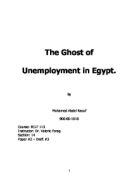b)
There are many causes to unemployment, which are split into categories.
Frictional unemployment is transitional unemployment due to people moving between jobs such as workers entering the labour market, such as university graduates. It may take time to find an appropriate job. Many are only unemployed for a short time while looking for work.
Structural unemployment occurs when people are made unemployed because of capital-labour substitution or when there is a long run decline in demand in their particular industry. Structural unemployment exists when there is a mismatch between the skills and the requirements for the new job opportunities. Many of the structural unemployed came form the manufacturing industry such as coal and steel. These workers find it hard to get employment without getting retrained, as their skills are unlikely to be required in a declining industry.







